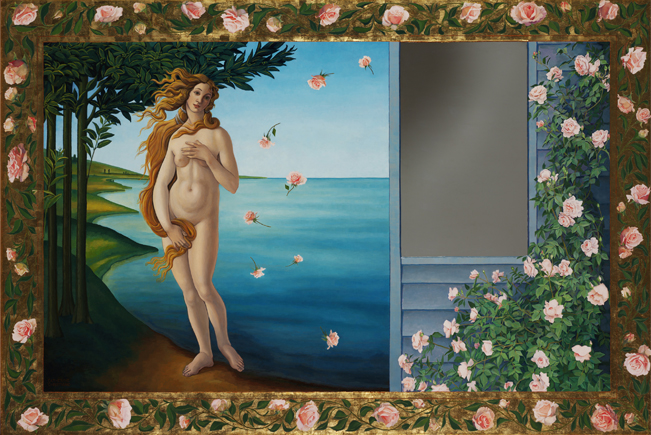
MYTH AND REALITY
STATEMENT
Myth and Reality, one of my major works, was created over the period of time extending from 2007 to 2009, following a brief trip to Italy. It reflects my interest in exploring the depiction of the human form and the role of the viewer in visual art. This painting is part of my ongoing Spectator series.
The dominant visual element in this piece is Botticelli's Venus, who emerges from the sea where she was born as roses fall from the sky towards her feet. Botticelli's female figure is not based upon an actual model from his time, but rather is representative of the fifteenth century Italian Renaissance archetype of beauty. With her abundant long strawberry-blond hair, flawless ivory skin, large wide-set eyes, high arching delicate eyebrows, rosebud lips, unnaturally elongated neck, steeply falling shoulders, small bosom, rounded abdomen, wide hips, modestly positioned delicate hands and fingers, and highly arched diminutive feet, she is a chimera, a composite of ideal parts, existing only in the imaginary world of the painting and not possible in reality. The Botticelli-like landscape similarly represents a unification of ideal elements, an azure sky above a calm blue sea that delicately meets a gently undulating shore with low golden green hills and bitter orange trees that have perfectly straight trunks and leaves spiked with gold. In contrast, on the right side of the panel is an image that seems more ordinary but is actually equally contrived. The gray clapboarded exterior of a home includes a mirror where a window should be. The mirror places our reflection in the more ordinary world within the painting. A garden-variety climbing rose surrounds the window and contrasts with the garland of perfect rose blossoms set inside a gold border that unifies and frames the entire piece. The painting in turn is a composite of images but with contrasting elements, the ideal figure of the goddess versus our own real bodies, the perfect landscape laced with gold versus the reality of our own surroundings.
On another level, this painting also invites us to consider our role as participants in visual art. The figure of the Venus has been clearly crafted for our gaze; as she steps away from the water she presents herself to us as a classical icon of beauty. She averts her gaze as her hair wraps around her body and together with one hand conceals her pubis while her other hand covers one breast yet reveals the other. The roses that fall from the sky sweep downward and around towards the climbing roses that form a visual line drawing our eyes to the mirror and our own image. It is here that we are confronted by our gaze and made aware of our role as participants and as subjects of the painting.
--- Catherine Christiano
